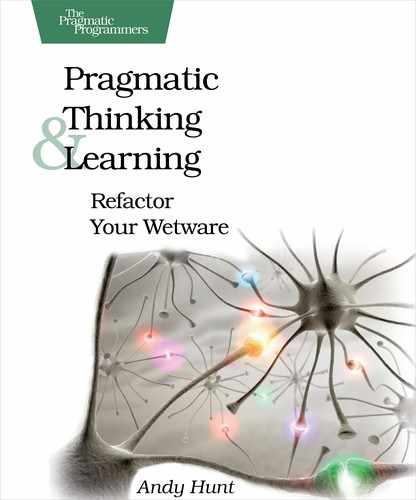Your Dual-CPU Modes
CPU #1 is probably the most familiar to you: it is chiefly responsible for linear, logical thought, and language processing. It’s like a traditional von Neumann--style CPU that processes instructions step-by-step, in order. CPU #1 is relatively slow and uses a relatively small amount of overall brain real estate.
It’s programmed with an “idle loop” routine as well. If CPU #1 is not processing anything else, it will simply generate an internal stream of verbal chatter. It’s that little voice in your head.[27]
CPU #2, however, is very different. Instead of the linear, step-by-step approach of CPU #1, CPU #2 is more like a magic digital signal processor. It’s your brain’s answer to Google: think of it like a super regular-expression search engine, responsible for searching and pattern matching. As such, it might grab matching patterns that aren’t obviously related. It can go off searching while you are “thinking” of something else and return a result set asynchronously—and possibly days later. Since CPU #2 doesn’t do any verbal processing, that means its results aren’t verbal, either.
Notice that both CPUs share the bus to the memory core; only one CPU can access the memory banks at a time. That means if CPU #1 is hogging the bus, CPU #2 can’t get at memory to perform searches. Similarly, if CPU #2 is cranking away on a high-priority search, CPU #1 cannot get at memory either. They interfere with each other.
Two CPUs provide R-mode and L-mode.
These two CPUs correspond to two different kinds of processing in your brain. We’ll call the linear processing style of CPU #1 linear mode, or just L-mode. We’ll refer to the asynchronous, holistic style of CPU #2 as rich mode, or R-mode for short.
You need both: R-mode is critical for intuition, problem solving, and creativity. L-mode gives you the power to work through the details and make it happen. Each mode contributes to your mental engine, and for best performance, you need these two modes to work together. Let’s start looking at the details of each of these vital cognitive modes.
Memory and Bus Contention
R-mode is very important to your day-to-day work: it acts as your search and retrieval engine for long-term memory and ideas that are “in process.” But as I mentioned, R-mode doesn’t do any verbal processing. It can retrieve and recognize verbal elements, but it can’t do anything with them by itself because of that memory bus contention between L-mode and R-mode.
For instance, have you ever had the experience of trying to describe a dream when you first wake up? Many times it seems that a crystal-clear, vivid dream evaporates from your memory as soon as you try to describe it in words. That’s because the images, feelings, and overall experience are R-mode things: your dream was generated in R-mode. As you try to put your dream into words, you experience a sort of bus contention. L-mode takes over the bus, and now you can’t get at those memories anymore. In effect, they aren’t verbalizable.[31]
You have amazing perceptual powers, many of which can’t be effectively put into words. For instance, you can instantly recognize the faces of a large number of familiar people. It doesn’t matter whether they’ve changed their hairstyle, changed their manner of dress, or put on ten pounds or twenty years.
But try to describe the face of even your closest loved one. How do you put that recognition ability into words? Can you make a database describing the faces of the people you know in such a way that you could recognize them based on that description? No. It’s a great ability, but it isn’t rooted in the verbal, linguistic, L-mode.
And to compound problems, the R-mode search engine isn’t under your direct conscious control. It’s a bit like your peripheral vision. Peripheral vision is much more sensitive to light than your central vision. That’s why if you see something faint out of the corner of your eye (such as a ship on the horizon or a star), it can disappear if you look at it head-on. R-mode is the “peripheral vision” of your mind.
R-mode isn’t directly controllable.
Have you ever had the solution to a vexing problem (a bug, a design problem, the name of a long-forgotten band) come to you while you’re in the shower? Or sometime the next day, when you aren’t thinking about it? That’s because R-mode is asynchronous. It’s running as a background process, churning through old inputs, trying to dig up the information you need. And there’s a lot for it to look through.
R-mode is quite diligent at storing input. In fact, it’s possible that every experience you have, no matter how mundane, is stored. But it is not necessarily indexed. Your brain saves it (writes it to disk, if you will) but doesn’t create a pointer to it or an index for it.[32]
Have you ever driven to work in the morning and realized with a start that you have no memory of actually driving the last ten minutes? Your brain recognizes that this isn’t terribly useful data, so it doesn’t bother to index it. That makes remembering it a little difficult.
However, when you’re trying hard to solve a problem, R-mode processes will search all your memory for matches that might aid in the solution. Including all this unindexed material (and perhaps that lecture in school that you half-dozed through). That might really come in handy.
We’ll see how to take advantage of that and look at particular techniques to help get around some of the other problems with R-mode in the next chapter. But first, let’s take a look at a hugely valuable but very simple technique to deal with the fact that R-mode is asynchronous.
